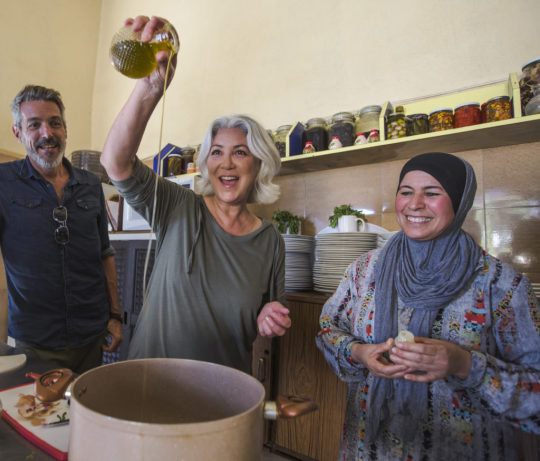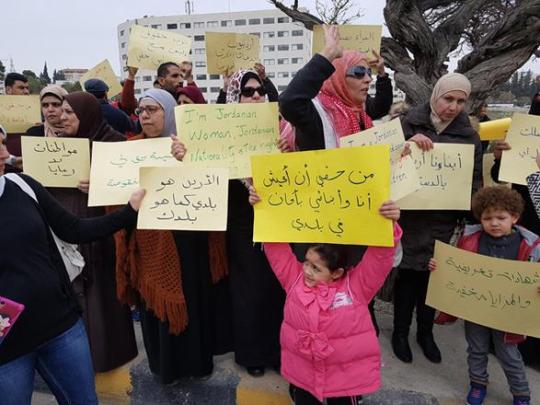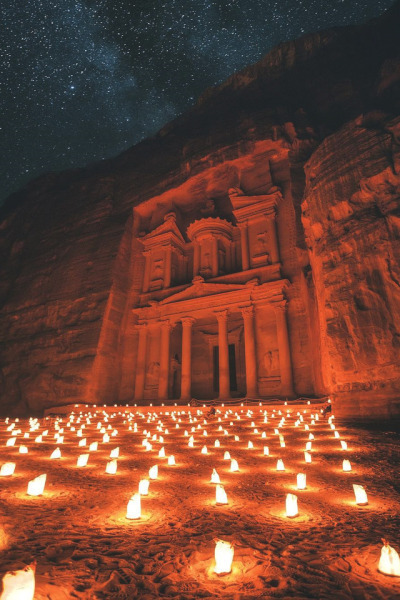Follow my journey through Jordan whilst I explore all things women's empowerment, anthropology & cultural and religious studies.
Don't wanna be here? Send us removal request.
Photo

Terrorism threats in Jordan
Whilst travelling, it is essential for individuals to navigate risks to ensure one’s safety. Before travelling to locations, I would recommend researching the risks associating with the region, for example, using the Smart Traveller website provided by the Australian Government. When researching Jordan, unquestionable risk that is highlighted is the threat of terrorism.
Jordan is perceived as a safe and welcoming destination, however, in reality the Australian Government’s official advice urges travellers in Jordan to be conscious that extremists aim to attack Westerners (Smart Traveller 2020). In the past four years, there have been five attacks against Westerners, reflecting the anti-Western sentiment that is prevalent in the Middle East. The most recent was in November 2019, where an attacker injured four tourists and four local citizens at the Jerash Roman ruins Visitor Centre (Smart Traveller 2020). This highlights that terrorists are prone to targeting tourist areas and attractions, as well as Western businesses (Smart Traveller 2020).In the Middle East, religious sectarian divides create serious tension and cause many conflicts, as seen in the Syrian and Iraq Civil War. Jordan’s neighbours, Iraq and Syria, are two of the most volatile countries in which leads to flow on effects that increase risks for travellers (World Nomads 2020).
It is important, thus, to be aware of this when travelling and take the suggested advice. The Australian Government suggests to:
be aware of the kinds of places that terrorists target, and the level of security in place
stay at hotels with a visible security presence, such as uniformed guards and screening tools that work
have a clear exit plan if you visit a possible terrorist target, in case there's a security incident
be alert to threats at tourist places, religious sites, Western businesses and crowded public places
report any suspicious activity or items to police
Picture: Recent terrorist attack at the Jerash Roman ruins Visitor Centre, piocture from Gulf and Globe (2019), https://www.gulfandglobe.com/jordan-charges-stabbing-attack-suspect-with-terrorism/
0 notes
Photo

Travelling during Ramadan
Plunging into the unfamiliar is scary, however, I believe this is one reason why we travel, to be challenged and learn ways of overcoming difficulties, such as culture shock, in life (Hottola 2004, 447). When travelling, I know that culture shock is inevitable so, as a global citizen, I aim to prepare for and embrace this feeling.
Whilst travelling Jordan, I believe it is essential to be aware that Sunni Islam is the dominant religion and is crucial to local’s daily lives. Ramadan is important particularly during the ninth month of the Islamic calendar. This month long holy Islamic holiday involves followers fasting from drinking, eating immoral acts and anger dawn until dusk (Al Jazeera 2020).
Ramadan is an opportunity for Muslims to refocus their minds on Allah (Sievert 2006, 6).
Here are the top tips for travellers during Ramadan.
1) Business hours
Businesses in Jordan will change trade hours to accommodate for this, for example, restaurants won’t upon until after sundown.
2) Sleep schedule
Jordanian’s sleep schedule changes significantly during this time. Muslims aim to sleep during the daylight fasting hours and are instead active during the night (Six Aboard 2013).
3) Legal offences
Do not eat or drink in public during the daylight hours as it is illegal (Australian Government 2020).
By giving you these tips, you’ll be better prepared for travelling and culture shock during this Ramadan season.
However, it is important to embrace and observe this Islamic festival to fully appreciate Jordanian culture. Also, the food is phenomenal during the festival, so don’t forget to appreciate this! To learn more about this, click here!
Picture: Amman during Ramadan, taken by Obaida Kdeir (2016), viewed 18 May 2020, https://www.flickr.com/photos/139215852@N05/27370577442
0 notes
Photo

Mindful Tourism in Jordan
An opportunity for tourists to meaningfully engage is through by empowering women economically. One example of this is through supporting businesses, for example, Bait Khayrat Souf.
This business aims to provide local women with a platform to financially support themselves by making and selling natural and handmade products (Simms 2019).
Another similar business is Beit Sitti, which employs local women to take cooking classes.
As an individual with enough wealth to travel far and wide, I believe that I have an ability and opportunity to spend my money responsibly.
Supporting business that aim to empower women by raising their standard of living and allowing them to engage economically is an example of meaningful engagement.
This highlights my belief that is important in an increasingly globalised world to support local businesses.
As referred to in my last blog post, the Syrian Civil War has resulted in a devastating refugee crisis and Jordan has been active in helping these individuals. As a global citizen, I too feel it is my duty to meaningfully engage with this refugee crisis.
One opportunity to do so is by supporting the Syrian Jasmine House. This is a business that employs Syrian refugees that are overwhelmingly female and may be widowed or have had to leave their husband (Shapiro 2018).
7 percent of Syrian women in Jordan are employed, so supporting social enterprises that endeavour to financially support these women is important (Shapiro 2018).
Tourists are encouraged to buy the products, as well as engage in experiences, for example, Aleppo soap making and crochet classes (Jordan Tourism 2020). By choosing to be an ethical and thoughtful tourist, I believe one experiences a more meaningful experience, in which fully aims to understand, and support local grievances.
Picture: Cooking Classes at Beit Khayrat, taken by Rhea Simms (2019), viewed 17 May 2020, https://planeterra.org/women/beit-khayrat-souf-is-changing-lives/
0 notes
Photo

‘Strength’: Empowering Women
Amman’s street art is a must-see for all travellers when visiting this cultural hub! With pieces dedicated to ranging themes from equality to diversity, this is not to be missed!
A favourite mural of mine is titled “Strength” (pictured).
This Jonathan Darby piece is situated on a building located ten kilometres away from the Syrian border. This building is a gym used by both Jordanian and Syrian women and provides them a safe place to gather (Bosoletti 2016). After many years of Civil War in Syria, this gym is significant as it provides these women with a safe and supportive environment, as highlighted in Darby’s piece.
This mural undoubtedly stands as a ’beacon of inspiration’ for all women who see this piece to continue to be resilient in times of hardship (Bosoletti 2016).)
Street Art theorists suggest that this medium has potential for political resistance (Millner 2017,3). This piece can be seen as an example of Darby empowering the women of Jordan and Syria and their resistance.
The Syrian Civil War can be seen as one of the most violent episodes in the history of the region and has resulted in refugee crisis (MacQueen 2018 ,335).
As Syria’s neighbour, Jordan has played a great role in supporting the refugees with its population being made up of over 10 percent of Syrian refugees (World Food Program USA 2020).
Women and children make up most of these refugees. Hence, Darby’s piece provides both local and visiting audiences an insight into the strength demonstrated by the women of Syria and Jordan.
I find the increasing popularity of murals in Jordan incredibly moving and inspirational as they provide local and international artists opportunities to grapple with social and political issues in new ways.
The Underground Amman Tour gives you an opportunity to engage with Jordan’s Street Art and support this political resistance.
Photo: An image of “Strength,�� taken by Jonathan Darby (2016), viewed 1 May 2020, https://www.montana-cans.blog/strength-jonathan-darby-village-kharja-jordan/
0 notes
Photo

Misrepresenting Jordanian Women
I have always perceived Jordan’s monarchy, headed by King Abdullah II, as a progressive and liberal regime that aims to empower women. This is exemplified with Jordan’s education system ensuring equal access for both young men and women (US Aid 2020). Statistics that reinforce this representation are that Jordanian women are among the most highly educated in the Middle East and North Africa region (Freedom House 2016).
However, this understanding is sadly a misrepresentation of the true lived experience of women in Jordan.
Statistics suggest that one-fifth of women are engaged in the workplace (US Aid 2020).
In the 2020 Global Gender Gap Index, Jordan ranked 145 out of 153 countries in terms of economic participation and opportunity (World Economic Forum 2020).
This economic marginalisation highlights the receding of women’s rights in Jordan.
Another example of this is Amnesty International’s 2019 campaign challenging Jordan’s abusive jail system in which allows for the arbitrary detention of women if they disobey their male ‘guardians’ (Dehgan 2019). This patriarchal system of male ‘guardianship’ allows for the controlling of women’s lives as well as limiting their personal freedoms (Dehgan 2019).
These socio-political and economic circumstances have resulted in Jordanian women protesting for decades.
Prior, I believed Jordan as a democratic and empowering state in which was devoted to promoting gender equality and women’s empowerment (US Aid 2020).
However, I now see this misrepresentation clearly. However, around the world, including in Western countries, women are subject to economic marginalisation and gender inequalities (Magistad 2017).
It is, thus, important to celebrate the progress made by Jordan, yet still encourage ongoing improvement for Jordan’s women.
This understanding is crucial to have when travelling, especially as a young woman like myself, as one should be aware of local customs, traditions and power structures.
Picture: Women protesting in Amman, Jordan, taken by Rana Husseini (2017), viewed 17 May 2020, https://www.jordantimes.com/news/local/protesters-demand-full-rights-children-jordanian-women-married-foreigners
0 notes
Photo

Petra: A Symbol of a Lost Civilisation
This lost civilisation symbolises the rich and ever-present history of Jordan’s territorial borders, which has hosted many of the world’s oldest civilisations throughout history. Petra’s pink sandstone walls symbolise not only Jordan’s ancient beauty but the rich culture we witness in Jordan today.
Lost for centuries to the Western world, the archaeological wonder, Petra, wasn’t rediscovered until the early 1800’s by a European traveller (Sanchez 2020). Today, the Rose City’s indescribable beauty is now considered a UNESCO World Heritage Site and one of the new seven wonders of the world (Jacobs 2018). However, more importantly, it serves as a national icon for Jordan.
Dating back to the third century BC, the capital of the Nabatean Empire is today regarded as a representation of Jordan’s most vibrant period of history (Lonely Planet 2020). This colourful reputation stems from the Nabatean’s well-renowned talent for trading incense and other precious goods between neighbouring nations (National Geographic 2018). The boundless wealth and influence spanning from Syria to Rome that arose from this made the Nabateans a powerful tribe (Jacobs 2018). Petra’s location as a crucial crossroad between the Mediterranean and Arabian seas on the Incense Routes, can be attributed to this abundant influence.Religion played an important role in the Nabatean tribe’s daily life (Erickson-Gini 2015, 310). The main God in which the Nabatean’s worshipped was Dushara, in which Petra’s main temple of Qasar al-Bint is consecrated to (Erickson-Gini 2015, 309).
Sadly, Petra’s beautiful tombs and facades are in grave danger of being destroyed by the impacts of tourism. Tourism in Petra was only boosted with its appearance in movies including Indiana Jones & the Last Crusade. This has been great for Jordan’s economy and tourist industry. However, a modern traveller when considering visiting Petra must be aware of its fragility and act accordingly. Hence, the use of Petra as a tourist symbol must be scrutinised as it may result in its destruction.
Picture: An image of Petra at night, taken by Cuma Cevik (2019), https://cumacevik.co.uk/nature-landscapes
0 notes
Quote
And we travel, in essence, to become young fools again — to slow time down and get taken in, and fall in love once more.
Iyer, Pico (2000). 'Why We Travel'. Salon.com. Available at: http://picoiyerjourneys.com/index.php/2000/03/why-we-travel/
1 note
·
View note